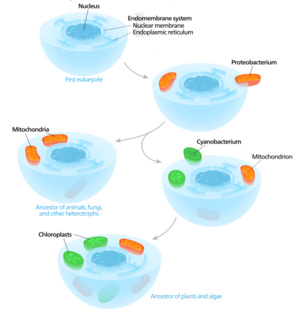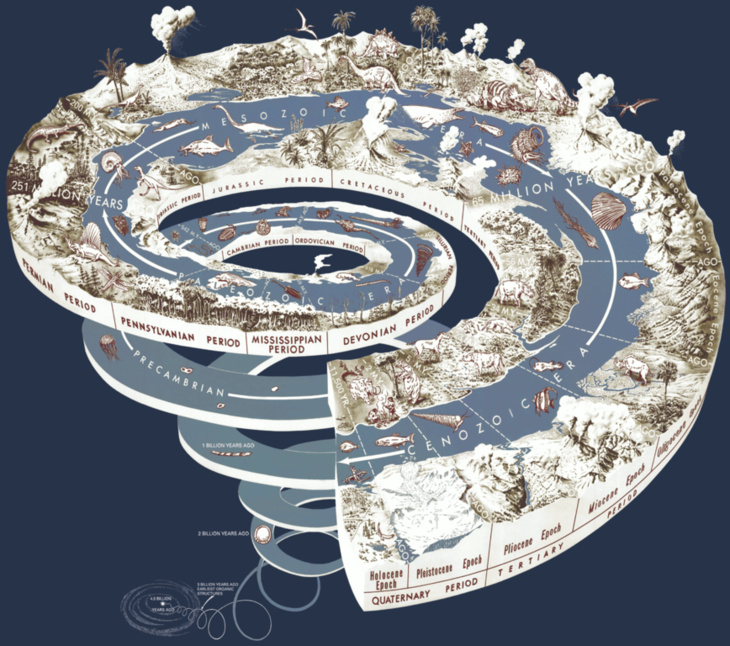-
February 01, 2016
Goodbye! -
January 18, 2016
A Fungus-farming Bee -
January 04, 2016
When The Going Gets Tough, The Tough Become Babies -
December 21, 2015
Adapting to a Cheesy Lifestyle -
December 07, 2015
Are GMO Fish Safe for the Environment? -
November 16, 2015
Divide and conquer: coaxing cheaters to battle ... -
November 02, 2015
Body Armor is Not Always for Protection -
October 19, 2015
Pre-adapting to Evolve -
October 05, 2015
How Fungus Makes Ant Zombies -
September 28, 2015
Learning from Lice -
September 21, 2015
An Incredibly Complete Tree of (Part of) Life -
September 14, 2015
Humans Evolved to Enjoy Songs and Music -
September 07, 2015
Dogs Have Co-opted Our Physiology to Win Our He... -
August 31, 2015
A Life of Ice and Clouds -
August 24, 2015
Evolving by Alternative Splicing -
August 17, 2015
Of Moss and Microarthropods -
August 10, 2015
The origins of kin discrimination—telling... -
August 03, 2015
Cooperating for Selfish Reasons -
July 27, 2015
Tinkering with Fins -
July 20, 2015
How We Know the Colors of Prehistoric Animals -
July 13, 2015
An Introduction to Sexual Selection -
July 06, 2015
Song Battles With Other Species Can Change Your... -
June 29, 2015
Was the Jurassic World a Dinosaur's World? -
June 22, 2015
The Evolution of Suicidal Sex -
June 15, 2015
Warning Signals Evolved From Other Functions -
June 08, 2015
Jumping Jaws Help Ants Escape From Pit Monster -
June 01, 2015
Mind-Manipulating Slave-Making Ants! -
May 25, 2015
Shape Matters for Gene Expression -
May 18, 2015
How Dogs and Humans Grew Together -
May 11, 2015
A Dinosaur That Flew on Bat-like Wings -
May 04, 2015
Counting Chicks -
April 27, 2015
A Groovy Cervix Helps Sperm Swim -
April 20, 2015
What Drove the Great Dying? -
April 13, 2015
The pan-genome of Emiliania huxleyi -
April 06, 2015
Behavioral Transplants -
March 30, 2015
Drug resistance evolves in inbred parasites -
March 23, 2015
What did the earliest skulls on land look like? -
March 16, 2015
The Oldest Jewelry in Europe -
March 09, 2015
The Evolution of Human Cortical Development -
March 02, 2015
Choosing Mates Wisely Is All The More Important... -
February 23, 2015
Evolutionary Constraints from Regulatory Gene N... -
February 16, 2015
Tracking Down the Genes Behind Speciation -
February 09, 2015
Duelling Genitals -
February 02, 2015
Melatonin is Not a Magic Pill -
January 26, 2015
What Snakes Teach Us About the Mouse Body Plan -
January 19, 2015
For bone-eating worms, smaller is better -
January 12, 2015
Collective Personality and Our Environment -
December 22, 2014
The Bone-house Wasp -
December 15, 2014
How and When Did Humans Start Consuming Alcohol? -
December 08, 2014
Why Do Mosquitoes Bite Humans? -
December 01, 2014
Crocodilians Hunt With Tools! -
November 24, 2014
What Makes a Cat? -
November 17, 2014
Treehoppers have wings on their heads -
November 10, 2014
The Meaning of Fitness -
November 03, 2014
The Evolution of War and Peace -
October 27, 2014
The Giant Kangaroos That Didn't Hop -
October 20, 2014
What Do Whales Taste? -
October 13, 2014
The Plants That Died with the Dinosaurs -
October 06, 2014
Scientists Discover Mushroom-like Animals, Poss... -
September 29, 2014
Island Biogeography in the Era of Humans -
September 22, 2014
From chimps to chickens: how a little DNA can m... -
September 15, 2014
How Wolbachia Learned to Help Bedbugs -
September 08, 2014
How Some Critters Evolved to Eat Poison -
September 01, 2014
How Starvation Causes Heritable Changes -
August 25, 2014
The Need for Speed Constrains Evolution in Mammals -
August 18, 2014
How Tibetans' Ancestors Adapted to High Altitudes -
August 11, 2014
Horizontal Gene Transfer Promotes Altruism -
August 04, 2014
Does Biology Have Laws? -
July 28, 2014
The Language of DNA -
July 21, 2014
Friends Are Genetically Similar -
July 14, 2014
Of Mice & Microbiomes: Evolving Gut Bacteria in... -
July 07, 2014
The give-and-take between mothers and their off... -
June 30, 2014
The First Animal Reefs -
June 23, 2014
Spiders Hunt Fish! -
May 23, 2014
One Year On! -
May 19, 2014
Evolving Separate Tasks — How Somatic and... -
May 12, 2014
Evolutionary Biologists Should Study Female Gen... -
May 05, 2014
Reservoirs for Retrovirus Evolution -
April 28, 2014
The Viruses That Made Us -
April 21, 2014
Unravelling How Planaria Regenerate -
April 14, 2014
The Yeasts That Make Lager -
April 07, 2014
Speciation in Reverse -
March 31, 2014
Fossils of Early Stick Insects -
March 24, 2014
The Evolution of Body Plans: A TALE of two prot... -
March 17, 2014
Where Do Genes Come From? -
March 10, 2014
The Evolution of Adipose Fins -
March 03, 2014
Invasion of the Crazy Ants -
February 24, 2014
Evolution and Development of Leaf Shape -
February 17, 2014
How Limbs Evolved From Fins -
February 10, 2014
Dogs are not Domesticated Wolves -
February 03, 2014
Sex and sociality: the genetics of being different -
January 27, 2014
Why is there so much plant diversity in a tropi... -
January 20, 2014
We Are Each A Community -
January 13, 2014
A Balancing Act for Wolbachia -
January 06, 2014
The Secrets of the Snake Genome -
December 30, 2013
Metabolism and Body Size Influence the Percepti... -
December 23, 2013
How the Cavefish Lost its Eyes -
December 16, 2013
The Regulation of Recombination -
December 09, 2013
Personality and the Spread of Disease -
December 02, 2013
The Genetics of Speciation -
November 25, 2013
The Making of Sex Chromosomes -
November 18, 2013
What Cetaceans Can Teach Us About Cultural Evol... -
November 11, 2013
Suicidal Reproduction In Mammals -
November 04, 2013
These feet were made for walking, but what abou... -
October 28, 2013
The Mimic Octopus: Master of Disguise -
October 21, 2013
Constraints on Evolution -
October 14, 2013
Selfish Genes & Emergent Properties -
October 07, 2013
Honeybees Can Avoid Deadlock When Making Group ... -
September 30, 2013
Epigenetics and Evolution -
September 23, 2013
Antibiotics and Applied Evolution -
September 16, 2013
Hiding in Plain Sight -
September 09, 2013
Tracking the Evolution of a Virus -
September 02, 2013
Viral Genes In Our Brain -
August 26, 2013
Some City Birds Are Changing Their Tune -
August 19, 2013
Shaping the Balance of the Sexes -
August 12, 2013
Forewarned is Fore-armed: Crickets Exposed to P... -
August 05, 2013
In the Evolution of a Signal, What Comes First:... -
July 29, 2013
Attraction gone wrong: butterfly mating and hab... -
July 22, 2013
How the Rhino Beetle Got its Horn -
July 15, 2013
The Laws of Attraction: Mangrove Killifish Style
« Prev « Prev Next » Next »

























I hope that helps!
The Proterozoic starts way down, a bit past the white thing with "2 billion years ago" written next to it. It continues almost to the top, stopping on the second twist where it says "Cambrian period". And there will definitely be more about microbes on Accumulating Glitches – they were the only living things around for most of Earth's history and are still the dominant lifeform on the planet, so how could I possibly avoid talking about them? :)
(2/2)
I think the hydrogen & methane are dissolved in the water, so I'm not sure how well they would serve as an alternative energy source. Actually, since everything I saw in the paper was about isotope ratios, I'm not even sure what "rich" means here. It might just mean "much more than usual" but still not be much in absolute terms.
There's definitely a risk of contamination. The honest answer to the samples were taken and preserved is: I don't know. They described sealing the borehole with a "packer" and using a container designed to minimize contamination; they also let gas & water flow through to get rid of any remaining air before sampling. This is way outside my area of expertise, so I'm not in a position to critically evaluate their approach -- in fact, I'm not even sure I understand how they did it. I accept their work because I trust that it's been reviewed by someone who does know enough to be critical.
(1/2)
The world is certainly full of surprises and we can't know what we'll find unless we go out and look.
How is a sample like that preserved? When we touch it don't we immediately change it?
Is there an image of D.audaxviator from the South African sample?
Thanks Sedeer, i love the idea of connecting Earth's crust, Earth's surface, Earth's clouds, and Mars, all thinking in a thread of microbes.
ps-Where is Proterozoic on that spiral time/map?
pps-More on microbes, please!
Also, I strongly believe that one never, ever can know what practical benefits can come from discovering the tricks that previously unknown life may have. The history of science is full of examples. Just by studying fundamental biology we can have and have indeed gotten practical benefits in engineering and medicine among other fields. It is an oft used phrase, but truly, you will never know what you will get.
In a related note as for the ET life possibilities, yes, indeed, we can learn something, but beyond that, we can learn things that can help US survive whe we go "out there". Thanks for yet another great post!